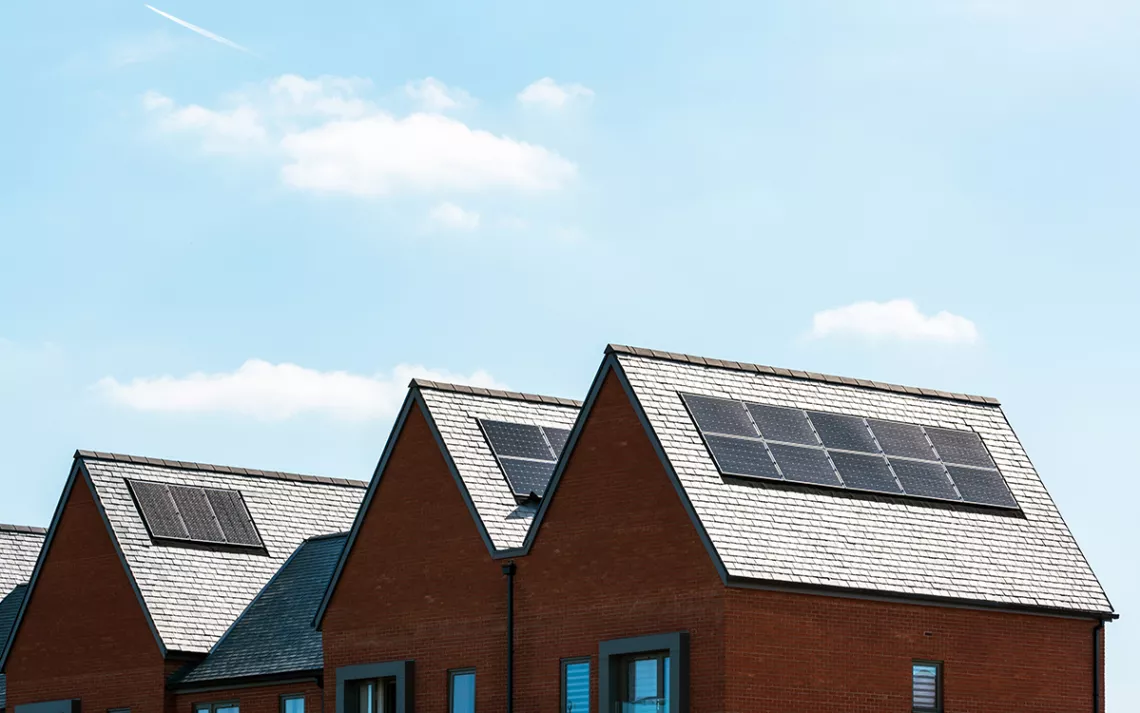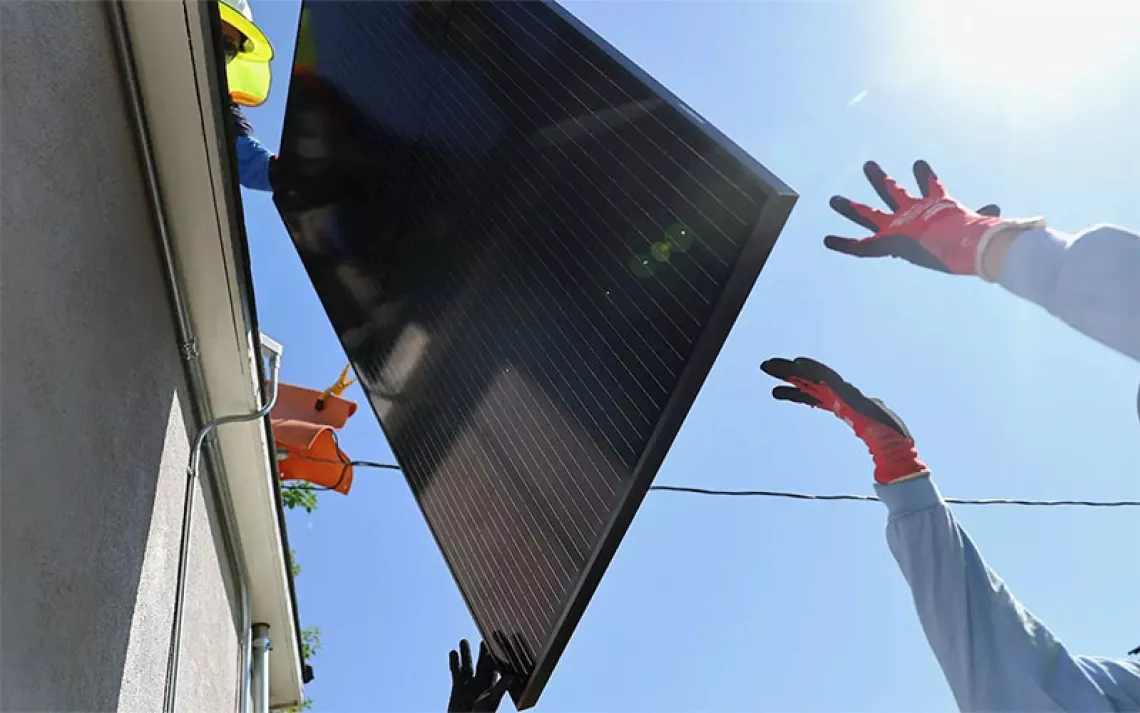The Stimulus Bill’s Climate Wins Are Significant But Just a Start
The Biden administration will need to build on these gains

Photo by yevtony/iStock
A few days before Christmas, the US Congress passed a major $900 billion COVID-19 stimulus bill, pared with a $1.4 trillion federal spending package. The main items that made the headlines were $600 checks to Americans, federal unemployment benefits, and funding for small businesses, school systems, public transit, and vaccine distribution.
Flying beneath the radar in the year-end legislation were a variety of energy- and climate-related provisions that together arguably made up one of the most significant actions on climate in years, at least from Congress.
The bill included an extension of the federal solar investment tax credit for two years at the 26 percent level, instead of dropping down to 22 percent in 2021 and 10 percent in 2022, as had been planned. Federal tax credits for wind were extended for one year, and offshore wind was made eligible for the first time, within a window lasting until 2025.
The stimulus also authorized $35 billion in funding over five years for programs at the Department of Energy that support renewables, carbon capture technologies, and energy efficiency. The bill authorized $1 billion for energy storage R&D as well as another $2.36 billion for grid modernization that will allow for better integration of electric vehicles, renewable energy, and energy storage. The legislation also directed the Department of Interior to target 25 gigawatts of solar, wind, and geothermal capacity on public lands by 2025.
The legislation also included a critical phase down of hydrofluorocarbons (HFCs), which are chemicals used in refrigerators and air conditioners that are hundreds of times more powerful than carbon dioxide in terms of their global warming impact. In 2016, an international agreement reached in Kigali, Rwanda, targeted the global elimination of HFCs, but the US never passed the specifics of the agreement into law. The latest stimulus and spending package effectively did just that, phasing HFCs down in the years ahead, a major win for the climate. Proponents say the Kigali agreement has the potential to eliminate a half degree Celsius of warming.
Environmental groups celebrated most of the provisions, although they had qualms about the support for carbon capture and nuclear power. Meanwhile, the US Chamber of Commerce—not historically a friend of climate action—called it “historic” and the “biggest action Congress has ever taken to address climate change, and the first energy bill in 13 years.”
But one of the “most impactful” near-term provisions, especially given the current economic crisis, relates to the Weatherization Assistance Program (WAP), according to Alexander Ratner, federal policy manager at the American Council for an Energy-Efficient Economy (ACEEE). “That's really one of the key and most important pieces of this bill that was passed,” he told Sierra.
According to ACEEE, one-fourth of all US households—and two-thirds of low-income households—have a “high energy burden,” meaning that more than 6 percent of their income goes to utility bills.
There are “stark demographic and regional disparities” between these energy burdens, ACEEE says. The burden is 43 percent higher for Black households than for white households, meaning Black communities spend a much larger share of their income just to keep the lights and heat on.
Retrofitting homes to make them more energy efficient costs money, typically up front. WAP provides funding for low-income households to retrofit their homes, saving money, energy, and also creating employment. The program supports 8,500 jobs and weatherizes roughly 35,000 homes per year, according to the Department of Energy.
In the latest spending deal, Congress reauthorized the program for several years and also made it much more flexible. It redesigned the program to allow renewable energy to qualify, potentially opening up access to solar panels for low-income communities. A series of administrative changes also should make it more accessible to more people, which could create new jobs and reach many more households. “It is a low-income assistance program, a health program, and a jobs program that also happens to be an energy efficiency program,” Ratner said.
Despite the long list of climate wins in the spending bill, much more is needed. New data finds that 2020 was tied for the hottest year on record, capping off the hottest decade in human history. The United Nations estimates that in order to limit global warming to 1.5 degrees Celsius, the world needs to wind down fossil fuel production at the rate of about 6 percent per year through 2030. Yet governments around the world are on the wrong track, increasing production of oil, gas, and coal at a rate of 2 percent per year.
“We are kind of past the point of piecemeal incremental being what we need to do. Every year is the hottest on record,” Dr. J. Mijin Cha, assistant professor of urban and environmental policy at Occidental College, told Sierra.
Dr. Cha says that while extending tax credits for renewables is a positive development, US climate policy needs to be much more ambitious. Instead of spending time fighting to renew temporary subsidies every few years, “what we really need is large-scale public-sector development of wind and solar,” Dr. Cha said.
Moreover, climate policy should move beyond simply looking at greenhouse gas reductions and instead incorporate a more comprehensive vision that includes job quality, equity, and justice, Dr. Cha said. For example, the Green New Deal included calls for economic security, health care, affordable housing, and greater access to transportation. “And those things make people's lives better,” Dr. Cha emphasized.
The January 5 Senate elections in Georgia, in which both Democratic candidates pulled off upset victories, flipped control of the Senate. Those victories completely change the outlook for the Biden administration’s first two years in office, opening up a lot more possibilities for transformative climate policy.
Having shelved major stimulus plans after failing to take the Senate in November, the incoming administration may ramp up that ambition again. Some reports suggest the Biden administration is mulling a new $3 trillion infrastructure package, which may incorporate elements of his $2 trillion clean energy proposal that he trumpeted on the campaign trail. If even a part of his proposal becomes law, the recent climate wins in the year-end spending deal will look miniscule by comparison.
“Now is the time when Democrats don't really have an excuse not to govern. I'm so desperate to tell Democrats that we have to make people's lives better,” Dr. Cha said. “This is really the pivotal moment. What does the Democratic Party believe in? I think it has been too easy to skirt that issue because we have been on defense for so long.”
 The Magazine of The Sierra Club
The Magazine of The Sierra Club



